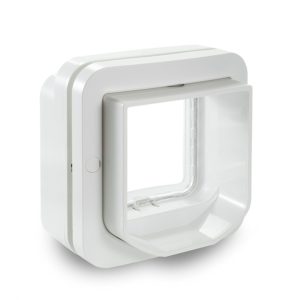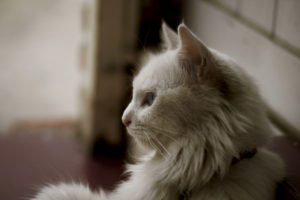Having cats as pets usually means porter-duty for you, the owner. Cat flaps are a solution, but having a standard, non-automatic flap might invite intruders into your house. If this is the case, automatic cat doors are the solution to your problem. In this article, we will review, and dive into the specifics, of the Cat Mate Elite Cat Door With Timer.
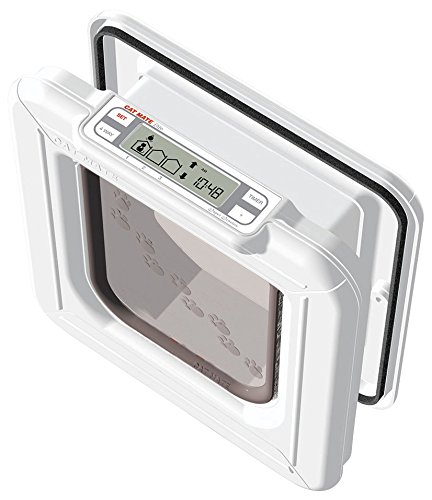
What Is The Cat Mate Elite Automatic Cat Flap With Timer?
The Cat Mate Elite is an automatic cat door that makes use of RFID technology to unlock the door mechanism for the cat, so your pet can push the flap and enter or exit. RFID stands for Radio Frequency IDentification.
The cat needs a pre-programmed RFID collar tag with its own personalized ID. The ID will get scanned by a control board in the electronic cat flap. The system unlocks when it recognizes the ID.
It’s a safe means of access control for pet doors because only animals with a preapproved RFID collar tag can exit or enter the flap.
When you purchase this device, it comes with two collar ID tags for you to register. The Cat Mate can hold up to eight ID’s in it’s built in memory. It can manage the entry and exit for up to eight pets of your choice. It keeps all undesired animals out. If you currently have more than two pets, you can buy additional tags separately. Collar tags are quite affordable.
SELECTIVE ENTRY & EXIT
The Cat Mate Elite features selective entry and exit access control. It does this using its special locking mechanism. The mechanism locks either the exit or entry, both, or neither.
By utilizing the method of selective entry, you can plan individually which cat will be indoor-only and which ones of your cats will have entirely free access to the outside.
The Cat Mate Elite Super Selective has a timer which enables you to program an outdoor routine for your cat.
The device comes with an LCD display. The LCD screen displays the currently programmed entry and exit lock status. IT also shows you if the cat is inside or outside. It also tells you the time the door was last used by that unique ID, to up to three cats.
The device comes with a 4-way locking system:
- both in & out-
- only inside
- only outside
- locked
The Cat Mate Elite door operates on four AA batteries. The batteries last around six to nine months, based on the usage and the quality of the batteries. Batteries are not included.
What Are The Features Of The Automatic Cat Flap?
- Suitable for small to medium size cats.
- It will keep all unwanted animals out.
- Only cats with the preregistered collar tags can enter/exit through the door, based on the settings you selected.
- Selective control: decide per cat who exits and enters.
- With the use of unique ID collar tags, you can control which cats will be indoor-only and which ones outside.
- Timed control access enables you to establish an outdoor routine for your cat. Like keeping the cats in after five pm.
- The LCD screen shows you the selected entry and exit lock settings, if your cats are inside or outside, and the last time the door was activated by which ID, You can look up the location of up to three cats.
- The Unit includes two electronic ID tags (can be set to work with up to eight unique ID’s).
- 4-way locking settings
- Has a battery life indicator
- It is powered by four AA batteries.
- Frame-lining up to two (50 cm), ideal for various types of installations.
- Extra liners for wall installations. You can buy these separately.
- A weather-proof, brush sealed, flap.
- A rain seal to keep water out and stop it from leaking.
Size And Dimension
Overall dimensions: 9.75″W x 10.5″H
Cut out Size: 6.5″W x 6.5″H
Diameter: 9.125″
Door size: 6″W x 6″H
Pet Max Shoulder Width: 5.7″
How Does This Device Operate?
The Cat Mate Elite operates through a control board, a scanner and a collar tag with a microchip. The chip acts as a key for the control board to read.
When the registered unique ID, located on the cat’s collar, gets scanned and recognized by the control board, a hinge unlocks. This action allows the cat to move the door with its head, nose or perhaps paws and get through.
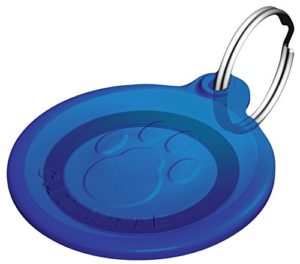
The activation distance is a couple of inches. The disc has to be close enough to the scanner to be read. Otherwise, the tag will not get read, and therefore the mechanism will not unlock.
The cat door takes approximately 1-2 seconds to open up after reading the pet’s ID. The flap needs about 2-3 seconds to fasten, depending on the settings you provided, giving the cat adequate time to go through the door.
When unlocking, the mechanism makes a clicking sound. This way the cat can learn it’s OK to push the door and subsequently go through it.
After the cat has cleared the door of its tail, the pet door makes a sound when locking.
The locking mechanism consists of small pegs that pop up from the frame into the base of the door.
This is the reason why the Cat Mate Elite Super Selective is promoted as raccoon-proof because the locking mechanism doesn’t rely on an outside control, or even a latch, that intelligent animals like raccoons or stray cats can easily manipulate.
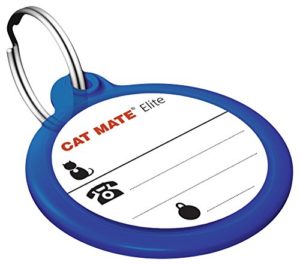
Cat Mate Elite operates through RFID collar tags. If your cat has a microchip implant, the implant will not interfere with the correct functioning of the automatic flap.
4-Way Locking Settings:
- In & Out: your pets using their respective collar tags have free access to exit and entry.
- In-Only: your pets can enter the door, but they cannot get back out.
- Out-Only: your pets can exit the door, but they cannot get back in.
- Locked: the flap is fully secured.
How Does The Programmable Timer Work?
The timer enables you to establish an outdoor routine for your pets.
For instance, if you would like your pet to exit the door starting from nine am, and remain inside after eight pm, you can schedule this with this particular pet door.
If you have a multi cat household, the timer will not have the ability to selectively determine which cat will continue to be inside or outside at predesignated times.
The routine of the timer is set for all cats simultaneously.
Example: all kitties will have the ability to go outdoors at ten am or even later, and they cannot leave the house to go to the great outdoors after five pm.
If it happens that one of your cats didn’t get inside before the time you set, the mechanism will not have your pet locked outside.
Your pets still have the ability to get in after the programmed time. They just can’t go back out.
The cat must find out how the method works to be able to use properly. Most cats find it easy to figure out how the automatic door works

.
For starters, the cat has to nudge the door with its nose, head or paws. Now the sensor begins searching for the RFID tag.
After the sensor registers the unique RFID code and recognizes it, the flap unlocks. The locking pegs disengage, producing a bit of a clicking sound. The cat must identify this sound, so it knows it can get through, push the flap and then walk through.
If the cat hesitates and remains at the same location, not entering the door, the device will lock once again.
Generally speaking, cats adapt very quickly to this particular pet door. Sometimes, they just need a bit of the right training.
Cat owners need the persistence to train the cat, as well as to hold out on relying on the cat to use it, until the cat feels self-assured enough to use it.
This may take anywhere from a few days to a few weeks, up to even a month, based on your feline.
Ultimately, all cats will want to use the door if they know adventure or food is waiting for them on the other side of the door.
The Cat Mate Elite Super Selective features a training mode setting which enables the cat exiting and entering the door without needing to make use of microchip or even watching for the press noise to push. With the training mode, the door is similar to a non- automatic pet door.
Tips On Training Your Cat To Use This Flap
This tip holds true for cats that have previously used a non-automatic pet door, and they already understand how to push the flap to get in or out.
The most important thing to do is to ensure that your cat will not hear the unlocking sound the very first time while pressing the door with its nose or head, trying to get in.
This may scare your cat to never wanting to use it again.
To prevent this from happening, you could trigger the locking system intentionally a few times while your cat is feeling secure somewhere in your home. Ultimately, your feline friend will come to investigate the strange new thing in the house.
This encounter already is special. Your cat will get used to this particular noise, and he or she will realize it’s not a threat.
It is certainly possible to reward your cat’s courageousness with treats in the progression.
When your cat becomes used to this particular noise, he or perhaps she can begin making use of the door with the RFID tag mechanism.
If your cat has never made use of a cat door, the owner’s manual has instructions and tips on the best way to train your cat to use an automatic cat door.
Basic Instructions on Installing This Flap
The standard set up doesn’t take more than thirty minutes. Nearly all of this time you will spend measuring the installation site and the automatic pet flap.
When you’ve cut the hole, it’ll be just a question of drilling two holes on both sides and subsequently screw the two halves of the automatic pet flap tight together.
It’s an excellent idea to find out where exactly to set up the pet door: the RFID microchip tag has to be at a certain level to be read by the scanner of the door. In case you mount the door too high, or perhaps too low, the microchip may not scan correctly.
However, the directions in the manual are very clear and easy to understand. If you stick to them, you shouldn’t have any trouble.
Wooden doors
Setting up the automatic cat door in flat wooden doors is actually the easiest.
After making sure of the correct measurements, draw the soon-to-be hole on the door. Then cut out the hole. Drill 2 holes, one on each side, and screw the 2 halves of the Cat Mate Elite together.
Metal doors
Installation in metal doors takes a bit longer. When installing the unit in a metal door, the door may not touch the metal directly. Touching metal will hinder the RFID signal.
Glass Doors or Windows
Generally speaking, it’s not advised to set up the cat door in glass panels. They might have way too much condensation.
We suggest you to invest in a glazier to cut holes in any glass objects. Then follow very carefully, the directions to set up the cat door.
It’s not easy to cut a gap in a double glass; you might have to get a brand new glass with the hole pre-cut in it.
When you prefer a simpler installation, you may want to change the glass board for Plexiglass and proceed as the standard installation.
Walls
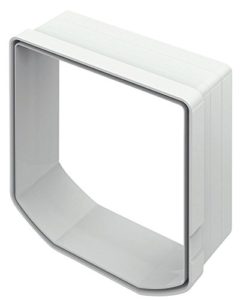
You probably need wall liners to set up the door in a wall. If a wall is quite thick, liners could be added in accordance with the Elite range.
A liner’s depth measures 1.96 (50mm).
How You Can Use It as A Timed Cat Flap Only
When you do not have any issues with unwanted animals entering your house; you just need a timed pet door.
Perhaps you simply do not wish to open the door every morning to allow your feline to go out, nor would you like to have to search for your feline buddy at night-time to keep him or her safely indoors at night.
This tip can help you:
Since the pet door doesn’t lock while in training mode, you might want to tape the RFID microchip to the interior of the cat door.
By doing this, with the correct settings, the door will invariably open. The chip is right there to be scanned by the scanner. Your cat will not have to utilize a collar tag, and with the timer, it’ll be locked in at night, and your pet will have the freedom to get out in the early morning, without the need of your in-person intervention.
The sole concern of setting up the cat door this means it’s the excess use of batteries, but it’ll be the price to pay to stop you from having doorman duty.
What Are The Advantages and Disadvantages Of The Cat Mate Elite Cat Door?
The Good
- 4-way locking setting
- Selective exit and entry management, you’ll be able to determine which cat will be indoor-only and which ones can swing both ways.
- Easy to set up in standard doors
- The LCD shows you the general location of your pets., which cat is in- and which one is outside. It also tells you the last time the door was used.
- The Catmate has a timer that enables you to establish an outdoor schedule for your kitties.
- Features an internal locking system that cannot be manipulated by animals from the outside.
- Helps to stop raccoons from entering your domicile.
- The length of time to secure the lock may be modified to your cats’ needs. It will provide your pet with adequate time to clear the automatic flap of its tail.
- It flaps a lot quieter than many other cat doors brands.
- It has battery life indicator.
- It may be put in training mode for your cat to get used, without it needing to use a microchip.
- If used in combination with a feeding station, you can check out if your cat has consumed.
- It does not leak much air in comparison to several other cat doors on the industry, keeping out the cold draft.
- Sturdy and well thought out design.
- Excellent for medium and small sized cats.
The Disadvantages
- Programming does not feel straight forward. You might need to read the manual.
- The device doesn’t appear to work very well when installed in solid metal doors?
- The microchip RFID tags are actually a bit big for cats, but they’re not heavy.
- The door makes a clicking noise when unlocking, similar to the noise level of an old deadbolt lock. It may scare your cat if not used to this sound.
- Tags don’t have a discount if you buy multiple at once. (a Con if your cat keeps losing its tag).
- The tag has to be close to the panel and facing it, to get scanned. The Door opening might not be appropriate for big or overweight cats.
- The timer doesn’t work separately for each ID; it works for every IDs simultaneously. Example: all cats reside in daily from six pm onwards).
- Occasionally the door locks erroneously, leaving the door stuck. However, this doesn’t often happen, and when it does, it is often only when cats take too long to go through the door.
- A bit tricky to put batteries into the compartment (you only need to do this every six weeks or so, so it might not be a huge deal.
- Screws aren’t that high quality.
Useful Tips, Tricks And Advice
- Make the flap opaque, by duct taping it or painting it.
You’ll realize two things by doing this:
- It will discourage raccoons or perhaps other cats from snooping inside, which gets them much more inspired to get in.
- It will discourage your cat from looking outside which might unlock the door unintentionally if sitting way too close
- Make sure to buy additional tags as backup
- If the door got locked with the pegs out, the very best way to reset the product is by using the training mode setting.
Push the system and 4-Way button together for five seconds. The program switch is placed under the battery cover.
This resetting retracts the pegs, and the door can swing back to original position. After that, you’ve to press the very same buttons once again to reset the door to its programmed setting. This way, you do not have to reprogram the ID’s.
- Make sure your cat’s tag is interacting correctly with the control panel’s scanner. If it is not doing this the right way, the scanner does not have the ability to check out the cat’s tag
- If your cat has pulled open a previous cat door with its paws, it’s a wise idea to secure the door manually, at night-time.
Because, if your cats are remarkably bright, they may be in the position to pull the flap inwards to get outdoors. For safety reasons, the door doesn’t secure from the outside when put in In-Only operating mode, for when the case occurs that in which a kitty accidentally gets out through the door or windows
Final Thoughts and Conclusion

The Cat Mate Elite is an outstanding automatic cat door, which works as advertised. We think this device is a better choice than its electromagnetic version.
The Cat Mate Elite’s ability to selectively recognize which cat can exit and/or enter, and the timer which enables you to establish a cycle for your cat or even cats, makes this particular device a remarkably good option for cat owners with more than one feline friend cat, and need all these functions.
The door only works with collar tags and not with implanted microchips. If your cat is a rowdy fighter or exceptionally adventurous and prone to lose its collar, you might want to rethink if it’s a good idea to have your cat wearing a collar with an attached door tag.
The device may not work well with indecisive cats; cats that are constantly thinking which step to take next. The door has a specific time frame for the cat to be fully inside. If your cat is slow, it’s tail might stop the flap from locking correctly.
Lastly, the cat door is promoted as raccoon-proof because it cannot be manipulated externally to unlock it.
However, there’s not a single cat door on the market which will not falter if an exceptionally powerful or large raccoon smashes the door over and over again, trying to break the flap mechanism. Exceptions will always exist, but for regular raccoons, the product works as advertised.
For all these reasons, we recommend Cat Mate Super Selective to:
- Small to medium size cats
- Self confident cats
- If you wish to stop a raccoon or the nosy neighborhood cats from entering your house
- If you own a number of cats and one or more of them are (temporary) indoor-only.
This cat door might not be suited for :
- Large or overweight cats
- Insecure or easily scared cats
- A cat who does not like wearing collars, and sheds them easily. We advise you to do a test run you cat for a week with a wearing a collar before you invest in this door.
- To be installed in metal doors or walls.

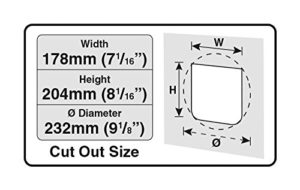
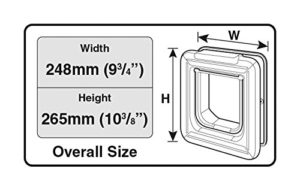
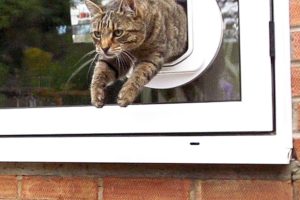
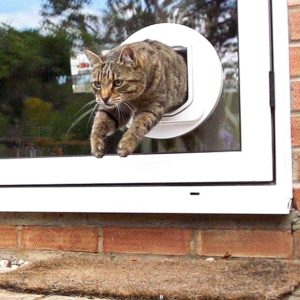
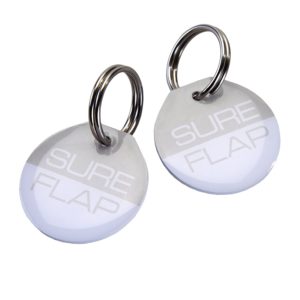
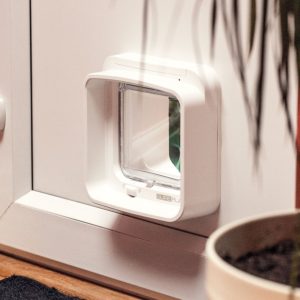
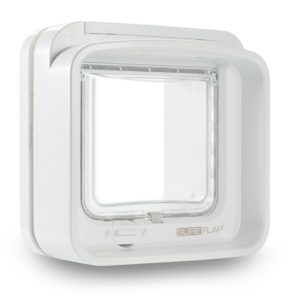


 Usage Tips and Advice
Usage Tips and Advice